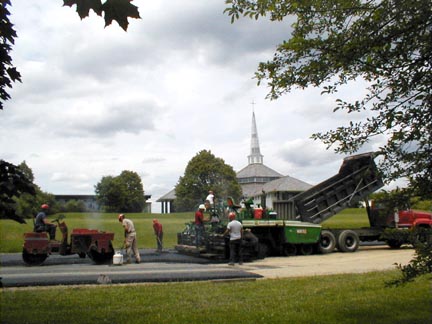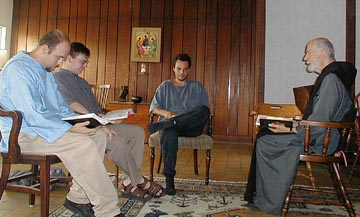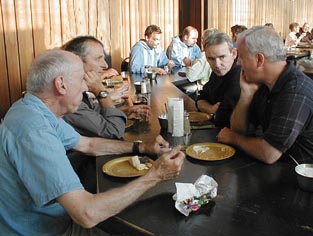
 The summer program began officially on July 4th. Richard Kosmicki, Gregory
Gricoski and Richard Neapolitan attended classes in the morning (shown
here with Fr. Martin) and helped with various works in the afternoon.
The month enable them to experience the life of the monks: worship, study
and work.
The summer program began officially on July 4th. Richard Kosmicki, Gregory
Gricoski and Richard Neapolitan attended classes in the morning (shown
here with Fr. Martin) and helped with various works in the afternoon.
The month enable them to experience the life of the monks: worship, study
and work.
The sixth in the lecture series for our 50th anniversary was given
by Fr. Jeremy Driscoll OSB of Mount Angel Abbey in Oregon. Fr.
Jeremy kept our rapt attention during his talk on the Contribution of Monastic
Life to the Church and the World. He began with the vision St. Gregory
relates of St. Benedict contemplating the whole world as contained
in a single ray of light. St. Benedict was grasping the meaning of
the whole world within something larger than itself. He was
understanding it within the light of Christ, and his whole monastic life
had been a preparation for this contemplative grasp. It is in a particular
kind of vision of the Church and the world that monastic life can make
its particular contribution.
The vision of St. Benedict shows us a wonderful
paradox of the Christian life. In virtue of the Christian's participation
the resurrection of Christ, the heart of the Christian becomes in a very
real sense larger than the world. Before Christ and the divine life
hhe brought to earth, we can say, rather naturally, that the world is a
macrocosm within which each human being is its microcosm. The world
is big, and each of us is small, each a small world. But in Christ,
nothing less than the very being of God-the trinitarian relations!-is placed
in the human heart. In this way, each believing person becomes the
macrocosm and the world its microcosm. This is what is signified
in the vision of Benedict. The whole world can be seen in a single
glance in Christ. The world is beautiful and stunning and something
to be loved, but in Christ my heart becomes bigger than the world and contains
it. The monk is meant to behold the world in a single contemplative
glance and to contain it within something larger, something larger, that
paradoxically lies within. As C.S, Lewis wrote in Narnia: "The
inside is larger than the outside." The monk is a "type" (or archetype)in
the technical sense of the term. And although a type must really
live the reality of his calling, the type bodies forth a truth that is
valid for the whole of society. Others, too, can learn the monk's
vision. When this happens, it can be called the monastic contribution.
The monk as a type is a very broad category and
history shows us many versions. What, can we say, are the distinguishing
characteristics of the Christian monk? The Christian monk has a special
calling to witness to the resurrection of Jesus Christ from the dead.
Of course, every Christian is called to be a witness to his, but each in
a particular way.
The monk is called to this witnessing as one summoned beyond
all signs, as one whose entire way of life offers clues to a reality that
is infinitely transcendent, as one who wrestles at ever greater depth with
the terrifying and joyful paradox that the risen Lord is met precisely
in the experience of his absence to all merely carnal modes of detecting
him. As St. Paul once exclaimed, "If once we knew Christ according
to the flesh, we no longer know him in this way." (2 Cor 5,16)
Fr. Jeremy than took us through the scene of Mary Magdalene at the tomb
of Easter morning.
Since we intend to publish these conferences in
book form, I do not want to reproduce the entire lecture here and to abbreviate
it at this point in its development would be to seriously distort it.
So you will have to await the book.
 What Fr. Jeremy suggested about the Magdalene shows us of monastic life
can be played again, briefly, in the key of St. Benedict's vision.
The monk is one who slowly learns that there is nothing in this world to
which he may cling, that virtually every thing, every person, every experience
will continue to whisper to him what the angels said to Mary: "He
is not here. Why do you search for the living among the dead?"
And "Do not cling to me." And in the assignment of a mission: "Go
tell my brothers." (John 20,17) The risen Lord is not here as we
would like in a visible, tangible way, but he is here in his own sovereign
way, here but unrecognized in the gardener sitting next to you, in the
hungry, the distraught, the stranger and the needy. And he is here
in the mission of announcing the Good News.
What Fr. Jeremy suggested about the Magdalene shows us of monastic life
can be played again, briefly, in the key of St. Benedict's vision.
The monk is one who slowly learns that there is nothing in this world to
which he may cling, that virtually every thing, every person, every experience
will continue to whisper to him what the angels said to Mary: "He
is not here. Why do you search for the living among the dead?"
And "Do not cling to me." And in the assignment of a mission: "Go
tell my brothers." (John 20,17) The risen Lord is not here as we
would like in a visible, tangible way, but he is here in his own sovereign
way, here but unrecognized in the gardener sitting next to you, in the
hungry, the distraught, the stranger and the needy. And he is here
in the mission of announcing the Good News.
Again, but leaving large gaps in Fr. Jeremy's presentation,
the light in which Benedict saw the whole world is the light of Christ
and is nothing less than Christ himself. It is the light that unaccountably
began to shine in the monk's own darkness, bringing with it an inexpressible
joy and hope. It embraces the whole world as well. This is
all gift and grace. The monk did nothing to bring it about.
If somehow monastic life could keep the Church and the world focused on
this hope, then that would be a contribution.
The picture shows John Boler who manages the physical
aspect of the meetings,
Br. Bruno, Fr. Jeremy and Dr. Anthony Cernera
who
is involved with the summer program.
Coming Events:
Monday, August 6th at 10:00am. The Feast of the Transfiguration
is the titular feast of the monastery, and Bishop Matthew Clark of Rochester
will preside and give the homily..
[On this day in 1951, Bishop James F. Kearney blessed the grounds and
buildings of the fledgling monastery.]
Sunday, August 19th. This is "Dedication Day," and the
10am Mass will as usual be followed by a light brunch; and there will be
musical presentations in the afternoon.
Previous month
Mount Saviour page
Guest Brother E-mail: guest@msaviour.org
Monastery E-mail: info@msaviour.org